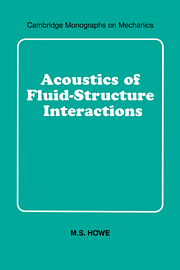4 - Sound generation in a fluid with flexible boundaries
Published online by Cambridge University Press: 22 March 2010
Summary
To determine the sound produced by turbulence near an elastic boundary, it is necessary to know the response of the boundary to the turbulence stresses. These stresses not only generate sound but also excite structural vibrations that can store a significant amount of flow energy. The vibrations are ultimately dissipated by frictional forces, but they can contribute substantially to the radiated noise because elastic waves are “scattered” at structural discontinuities, and some of their energy is transformed into sound. Thus, flow-generated sound reaches the far field via two paths: directly from the turbulence sources and indirectly from possibly remote locations where the scattering occurs. The result is that the effective acoustic efficiency of the flow can be very much larger than for a geometrically similar rigid surface, even when only a small fraction of the structural energy is scattered into sound. Typical examples include the cabin noise produced by turbulent flow over an aircraft fuselage and the noise radiated from ship and submarine hulls, from duct flows, piping systems, and turbomachines [26]. Interactions of this kind are discussed in this chapter.
Sources Near an Elastic Plate
The simplest flexible boundary is the homogeneous, nominally flat, thin elastic plate, which supports structural modes in the form of bending waves. The effects of fluid loading are usually important in liquids, where the Mach number M is small, and in this section, it will be assumed that M ≪ 1 and, therefore, that mean flow has a negligible effect on the propagation of sound and plate vibrations.
- Type
- Chapter
- Information
- Acoustics of Fluid-Structure Interactions , pp. 253 - 316Publisher: Cambridge University PressPrint publication year: 1998



